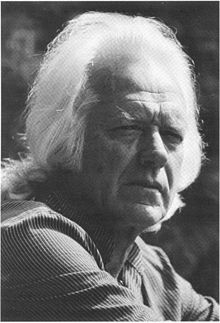Eduardo Villa
| Edoardo Villa | |
|---|---|
 |
|
| Born |
Edoardo Daniele Villa 31 May 1915 Bergamo, Italy |
| Died | 1 May 2011 (aged 95) Johannesburg, South Africa |
| Nationality | South African |
| Education | Andrea Fontini Art School |
| Notable work | The Knot, Cape Town Confrontation, Johannesburg Thrust, University of Pretoria |
| Movement |
Abstract art cubism |
| Awards | Honorary Professorship University of Pretoria Medal of Honour: South African Academy of Science & Art, 1979 |
Edoardo Daniele Villa (1915–2011) was a notable South African sculptor of Italian descent who worked primarily in steel, and bronze.
Villa was born in Bergamo, Italy and he studied at the Andrea Fontini Art School. While studying sculpture in Milan, in 1939, Villa was conscripted for two years into the Italian army at the outbreak of World War II. By 1940 he was posted to North Africa, where he was injured and captured in Egypt by the English. Some time between 1941 and 1942, he was shipped to South Africa where he then spent the next four years at the Zonderwater prisoner of war camp. Zonderwater was opened in February 1941 and by the end of 1942 and held 63 000 prisoners under the care of Colonel H.F. Prinsloo whose head was later sculpted in bronze by Villa for the military museum. After his release, Villa remained in South Africa where he continued his vocation as a sculptor.
Villa started work with conventional heads and figures and changed to work on stylized abstractions. His work includes abstract explanations of the human condition but retains some figurative concepts. Villa's work has a strong cross-cultural synthesis which involves the Italian and the African. It is clearly informed by the cubism of Picasso (who had discovered African art in Paris at the Trocadero).
Villa gave an interview in which he said, “After being a prisoner of war in South Africa I decided to stay and start my career because of the opportunities available for the youth, the ‘open space’ as opposed to the ‘closed’ life of a continental. Everything in Europe I felt had been done, questioned and exhausted. Here, in Africa, I felt I had the opportunity to explore ... If anything could sum up my fundamental concern in art, it is that of the human and the individual – the human condition …. Museums are marvellous but human participation, physical proximity and tactile engagement are more important.”
Villa's sculpture developed further during the 1950s, when the use of cut steel and bronze. At this time he also taught at the Polly Art Centre in Johannesburg. The Polly Art Centre was founded as an adult education institution; in 1952 it was converted into an art and exhibition centre. Until its closure in 1960, it was the only place – apart from a few private galleries – where black artists in Johannesburg could pursue their art and show their works.
In 1961, along with Cecil Skotnes, Cecily Sash, Giuseppe Cattaneo and Sydney Kumalo, Villa made up the artist group “Amadlozi” (Zulu for “ancestors”) for the conscious appropriation of African sculptural traditions.
...
Wikipedia
